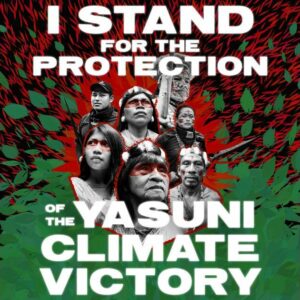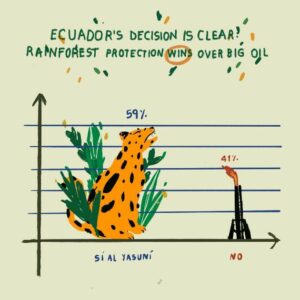Lago Agrio, Ecuador, November 28th, 2023 – An Ecuadorian appeals court has ruled in favor of the Siekopai Nation’s claim to regain ownership over their ancestral homeland known as Pë’këya, located on the border between the Amazon rainforest of Ecuador and Peru. The decision, issued by a three-judge panel from the Provincial Court of Sucumbios on November 24th, will mark the first time that the Ecuadorian government delivers a land title to an Indigenous community whose ancestral territory is found in a protected area, and sets an invaluable precedent for all Indigenous peoples fighting to recover their lands across Latin America and the world.
A hypnotic labyrinth of blackwater lagoons and flooded forests, Pë’këya is the ancestral territory and spiritual epicenter of the Siekopai Nation. It is home to some of the most biodiverse ecosystems on the planet, hosting at least 200 species of reptiles and amphibians, some 600 types of birds, and 167 mammal types. Many are threatened species, including the Amazon river dolphin, the giant otter, the manatee, and the arapaima, one of the world’s largest freshwater fish. The area is also the refuge of several important plant and animal species vital to the Siekopai’s daily existence such as the guazay mangrove, used for fishing equipment, and the gosa (ungurahua palm), whose fruits help young infants grow.
With a population of barely 800 in Ecuador and 1,200 in Peru, the Siekopai are on the brink of cultural and physical extinction. On both sides of the border, the Siekopai are currently waging legal battles to recover more than a half-million acres of land that were stolen from their ancestors. The Siekopai’s court victory recognizing Pë’këya marks a major stepping stone in this binational struggle for the reunification of their ancestral territory. After centuries of violence, racism, and conquest by colonizing missions, rubber corporations, and governments, the court’s recognition of the Siekopai as the owners of Pë’këya is an indispensable step towards restoring justice and guaranteeing their collective survival and the continuity of their culture.
Under a deadline of 45 days, the verdict requires Ecuador’s Ministry of Environment (MAATE) to deliver a property title for over 104,000 acres of biodiverse Amazonian land and public apologies to Siekopai elders and youth for its violation of their collective territorial rights recognized by international law and Ecuador’s Constitution. The Siekopai were forcibly displaced from their ancestral homeland during the Peru-Ecuador war in the 1940s and later prevented from returning when the Ecuadorian State unilaterally claimed ownership over Pë’këya in 1979 and designated the land as part of the Cuyabeno Wildlife Reserve, a protected area in the northeast of Ecuadorian Amazon, without the Siekopai’s consent.
The Siekopai’s case, filed against the Ecuadorian government in September 2022, was backed by a strong body of irrefutable evidence and juridical arguments: from powerful oral testimony by elders and youth on their connection to their land; 21 amicus curiae (friend of the court briefs) by diverse experts including two ex-judges from Ecuador’s Constitutional Court, anthropologists, ethnobotanists, historians, the regional office of the United Nations High Commissioner for Human Rights, and Indigenous communities (such as the A’i Cofán of Sinangoe and the Waorani of Pastaza, two Indigenous groups who won major legal victories against the Ecuadorian government); paintings by Siekopai artist Jose Cesar Piaguaje illustrating their nation’s spiritual origin in Pë’këya; 18th-century manuscripts of Jesuit missionaries acknowledging the Siekopai as the ancestral residents of the area; old Spanish colonial maps from the Royal Court of Quito in 1779; and territorial maps created by the Siekopai Nation over a four-year community-led mapping process, identifying historic and sacred sites, and important rivers and lagoons.
The victory, which comes on the eve of the COP28 climate talks in Dubai and on the heels of President-elect Daniel Noboa’s entry into office just days ago, sends a powerful message to the country and the world on the urgency of respecting Indigenous land rights and formalizing Indigenous land tenure as key climate solutions. It marks a major turning point in the fight to counter the top-down approach to conservation through national parks and protected areas created without the consent of Indigenous communities: time and time again, Indigenous peoples are proven to be the best guardians of their lands, which harbor 80% of the world’s biodiversity and are a low-cost, high-benefit investment in the fight against climate change.
The Siekopai people’s precedent effectively opens the path for other Indigenous communities seeking to secure legal titles and regain control over their ancestral lands in protected areas. In Ecuador, over 3 million acres of Indigenous territory are currently caught up in Ecuador’s national park system and still without title.
Declarations:
Elias Piyahuaje, Siekopai leader:
“This is a historic moment for the Siekopai Nation. The land of Pë’këya has always been and will always be ours. For over 80 years, we have been fighting to get our land back. Despite all the evidence regarding our land title claim – even historians testified that our ancestors dwelled in the area since the time of conquest – the Ecuadorian government failed to uphold our land rights time and time again. We are fighting for the preservation of our culture on this planet. Without this territory, we cannot exist as Siekopai people. Today is a great day for our nation. Until the end of time, this land will be ours.”
Justino Piaguaje, Siekopai Leader:
“We, Siekopai, have always belonged to this territory. However, it has taken decades of struggle to try to get the Ecuadorian State to recognize this sacred territory as ours. Our elders and our youth are so happy to finally return to our home, our spiritual heartland where our myths and the spirits from other dimensions await us. Although colonizers have tried to uproot us from this territory, they have failed. Now we have officially been able to recognize our land for the Siekopai, the Multi-Colored People.”
Mayra Piaguaje, Vice-President of the Siekopai Nation:
“We’re proud to receive such great news. I had faith and hope that we were going to make it. Throughout this case, we stood united as one nation – leaders, elders, and youth. This struggle has strengthened our culture. I feel proud to have recovered our territory for future generations. Our tears were not in vain.”
Maria Espinosa, Human Rights Defender & Lawyer at Amazon Frontlines:
“This victory has been decades in the making, it has been a very long struggle against the government. Now, finally, the Siekopai’s dream of recovering their ancestral territory has been achieved. This groundbreaking precedent paves the way for other Indigenous communities who dream of recovering their territories within protected areas. Thanks to the Siekopai victory, they may now move forward with more ease”.
Jorge Acero, Human Rights Defender & Lawyer at Amazon Frontlines:
“This is a precedent that opens the door for the defense of all Indigenous territories across the Amazon.” The Ecuadorian government for many years has refused to guarantee the right of indigenous peoples to legal security and ownership over territories in areas unilaterally declared protected by the State, violating their territorial rights; and as the ruling has said, their rights to maintain, strengthen and develop their cultural identity, ways of life and governance. This ruling is essential to open the way towards respect for the titling of these territories, and thus guarantee the physical and cultural survival of peoples and nationalities.
###
Siekopai leaders, elders, and youth are available for interviews, in addition to the Siekopai’s lawyers for their case. High-resolution photography and video available upon request.




